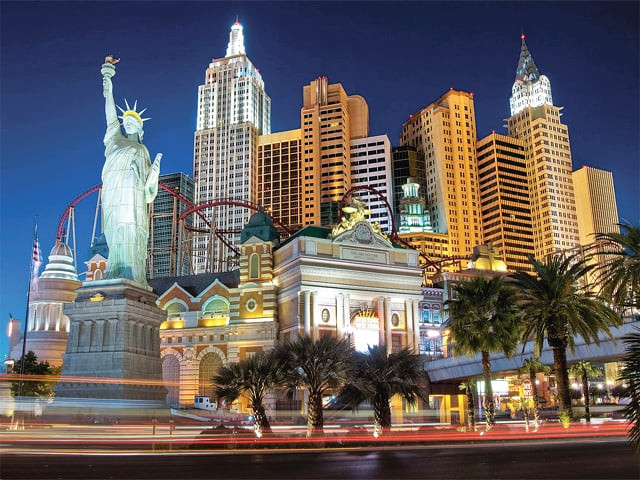
The jolt to the American economy sent shockwaves all the way to Vegas. Still, the greenbacks and the plastic money find its way to Vegas, and it seems the recovery process has begun. Gamblers and revelers come from every corner of the world to the legendary strip that stretches from that acme of modern architecture, the Mandalay casino, in the South of Vegas, to the icon of past glory, the Golden Nuggets casino, in the North. And they are not disappointed.
One of the cleanest and most well-maintained cities in the US, Vegas’ casino hotels are infinitely hospitable as long as you keep paying the dues. But before emptying my wallet at the casino table, I had to heed the calls of my empty stomach. The food and services here are amazingly cheap as Vegas tycoons adhere to the philosophy of their forefathers. They don’t mind plying you with cheap food and drinks, as the casino floors are their true sources of profit.
Downtown Las Vegas is not yet a prime dining destination, but El Sombrero is good for a meal or two, as is the Beat Coffeehouse and Records. After dark, pop into the Griffin for good beer, Downtown Cocktail Room for mixed drinks or the Beauty Bar for local bands.
The eating is much better out on Spring Mountain Road, which runs through the heart of Chinatown. Think Korean barbecue, Sichuan noodles, Vietnamese sandwiches, Filipino bakeries, Malaysian satay and Japanese izakayas. It would require volumes to cover the cuisine on offer, but one bit of advice is essential: if you are planning to visit Vegas, just leave your weighing scales back home.
The original Las Vegas is at the extreme north of the strip. What had once been a railroad town was transformed, with the passage of time and the wanton use of electricity, into the bewildering neon jungle that has come to symbolise Las Vegas. Casino themes have also experienced an evolution, from the Old West to Orientalism to Family-Friendly. At Lost Vegas, an antiques shop, every little bit of Las Vegas history is on sale. Commemorative boxing pins, a Marilyn Monroe mannequin, ashtrays from seemingly every casino throughout history — incredible.
The casino floors are an altogether different world. Here, there are more versions of slot machines than one can imagine and players can bet as low as one cent to as high as $100. The slots are just one part of the gambling spread: poker tables, roulette, crap tables, baccarat and much more keep both the amateur and professional gamblers involved.
Meanwhile, the waitresses take rounds offering players free drinks, dealers roll the balls in roulette, distribute the cards on poker tables, hoping to get every nickle out of the players’ pockets. The pit bosses keep an eye on the dealers, as the floor managers remain vigilant throughout their shifts. Massage girls knead away the physical and mental strain of gambling.
But according to Newsweek, Sin City has no jobs, and the newly homeless are living in drainage pipes. The unprecedented two-year economic crisis — with a total bleed of $6billion — is more than at any point in Las Vegas history. Official unemployment is near 14 per cent, the nation’s worst rate among big cities. But when you add those who have lost hours or dropped out of the labour force altogether, actual joblessness is a Libya-like 26 per cent, according to Stephen Brown, the director of the Center for Business and Economic Research at University of Nevada, Las Vegas (UNLV), quoted in Newsweek.
Now, Las Vegas might get its biggest act since Elvis. The shimmering French-Canadian singer, Celine Dion, has signed a $100 million three-year contract with Caesar Palace, which is expected to bring hundreds of millions more in revenue while creating new jobs.
Analysts are portraying Celine as a saviour as much as a star. The casino is paying her a reported $100 million for 210 shows over the next three years. During her prior run, from 2003 to 2007, Dion sold out more than 700 consecutive performances, smashing local records for total audience (nearly three million), and bringing in more than $400 million at the box office, more greenbacks than the Rat Pack, Liberace, and Elvis combined. “This time around, she’s being touted as a one-woman stimulus bill — worth at least $114 million a year and thousands of jobs, according to UNLV. But in an $18 billion–dollar economy — one so sluggish it was recently ranked among the five worst in the world — can Celine’s return really have an impact?” wrote Newsweek.
At the south end of the Strip, near the iconic “Welcome to Fabulous Las Vegas” sign, a hidden concrete path leads into a 500-mile warren of wet, trash-strewn drainage pipes that function as an underground shelter for hundreds of the city’s downtrodden. Several have been laid off from the same well-paid, benefits-packed service jobs. Vegas is no longer a working-class paradise. Life here is cruel and dangerous and, reportedly, the number of pipe-dwellers is increasing.
Recently, Mayor Oscar Goodman has described himself as “The Happiest Mayor of the Greatest City in the World.” Vegas has survived many odds in the past and is still surviving, even if the neon lights seem a little dimmer now.
Published in The Express Tribune, Sunday Magazine, March 27th, 2011.


















COMMENTS
Comments are moderated and generally will be posted if they are on-topic and not abusive.
For more information, please see our Comments FAQ